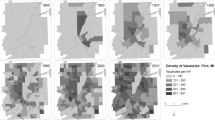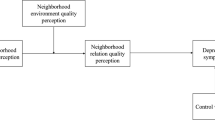Abstract
Macrostructural research in the social disorganization tradition assumes neighborhood structure dictates individual behavior. The current research explores the opposite perspective to determine whether individual attachment to the neighborhood influences perceptions of neighborhood safety. Using the Chicago Metropolitan Area Survey, the results show that loners, persons wishing to move, and renters perceive their neighborhoods as being less safe than attached residents. Implications for future research are offered.
Similar content being viewed by others
References
Austin, M. D., & Baba, Y. (1990). Social determinants of neighborhood attachment.Sociological Spectrum, 10, 59–78.
Baumer, T. (1985). Testing a general model of fear of crime: Data from a national sample.Journal of Research in Crime and Delinquency, 22, 239–255.
Bellair, P. E. (1997). Social interaction and community crime: Examining the importance of network structures.Criminology, 35, 677–704.
Bursik, R. J., Jr.&, Grasmick, H. G. (1993).Neighborhoods and crime: The dimensions of effective community control. San Francisco: Lexington Books.
Chiricos, T., Eschholz, S., & Gertz, M. (1997). Crime, news and fear of crime: Toward an identification of audience effects.Social Problems, 44, 342–357.
Chiricos, T., Hogan, M., & Gertz, M. (1997). Racial composition of neighborhood and fear of crime.Criminology, 35, 107–131.
Cooley, C. H. (1962).Social organization. New York: Schocken Books. (Original work published 1909).
DeFronzo, J. (1996). Welfare and burglary.Crime and Delinquency, 42, 223–230.
Defronzo, J. (1997). Welfare and homicide.Journal of Research in Crime and Delinquency, 34, 395–406.
Fried, M. (1982). Residential attachment: Sources of residential and community satisfaction.Journal of Social Issues, 38, 107–119.
Gillis, A. R. & Hagan, J. (1982). Density, delinquency, and design: Formal and informal control and the built environment.Criminology, 19, 514–529.
Gottfredson, D. C., McNeil, R. J., III, &, Gottfredson, G. D. (1991). Social area influences on delinquency: A multilevel analysis.Journal of Research in Crime and Delinquency, 28, 197–226.
Granovetter, M. S. (1973). The strength of weak ties.American Journal of Sociology, 78, 1360–1380.
Haggerty, L. J. (1982). Differential social contact in urban neighborhoods: Environmental vs. sociodemographic explanations.The Sociological Quarterly, 23, 359–372.
Heitgard, J. L., & Bursik, Jr., R. J. (1987). Extracommunity dynamics and the ecology of delinquency.American Journal of Sociology, 92, 775–787.
Houts, S., & Kassab, C. (1997). Rotter’s social learning theory and fear of crime: Differences by race and ethnicity.Social Science Quarterly, 78, 122–136.
Krivo, L. J., & Peterson, R. D. (1996). Extremely disadvantaged neighborhoods and urban crime.Social Forces, 75, 619–650.
Lavrakas, P. J., & Skogan, W. G. (1979).Citizen participation and community crime prevention, 1979: Chicago metropolitan area survey. Conducted by Northwestern University, Center for Urban Affairs and Policy Research. 2nd ICPSR ed. Ann Arbor, MI: Inter-University Consortium of Political and Social Research [producer and distributor], 1997.
Oliver, P. (1984). If you don’t do it, nobody else will.American Sociological Review, 49, 601–610.
Rountree, P. W., Land, K. C., & Miethe, T. D. (1994). Macro-micro integration in the study of victimization: A hierarchical logistic model analysis across Seattle.Criminology, 32, 387–414.
Rountree, P. W., & Land, K. C. (1996). Burglary victimization, perceptions of crime risk, and routine activities.Journal of Research in Crime and Delinquency, 33, 147–180.
Rountree, P. W., & Land, K. C. (1996). Perceived risk versus fear of crime: Empirical evidence of conceptually distinct reactions in survey data.Social Forces, 74, 1353–1376.
Sampson, R. J. (1988). Legal friendship ties and community attachment in mass society: A multilevel systemic model.American Sociological Review, 53, 766–779.
Sampson, R. J., & Groves, W. B. (1989). Community structures and crime: Testing social disorganization theory.American Journal of Sociology, 94, 774–802.
Shaw, C. R., & McKay, H. D. (1942).Juvenile delinquency and urban areas. Chicago: University of Chicago Press.
Smith, W. R., & Torstensson, M. (1997). Fear of crime: Gender differences in risk perception and neutralizing fear of crime.British Journal of Criminology, 37, 608–634.
St. John, C., & Heald-Moore, T. (1996). Age, racial prejudice and fear of criminal victimization in public settings.Sociological Focus, 29, 15–31.
Taylor, R. B., Shumaker, S. A., & Gottfredson, S. D. (1985). Neighborhood-level links between physical features and local sentiments: Deterioration, fear of crime, and confidence.Journal of Architectural and Planning Research, 2, 261–275.
Taylor, R. B. (1995). The impact of crime on communities.The Annals of the American Academy of Political and Social Science, 539, 28–45.
Walker, M. A. (1994). Measuring concern about crime: Some inter-racial comparisons.British Journal of Criminology, 34, 366–378.
Warner, B. D., & Pierce, G. L. (1993). Reexamining social disorganization theory using calls to the police as a measure of crime.Criminology, 31, 493–517.
Warner, B. D., & Rountree, P. W. (1997). Local social ties in a community and crime model: Questioning the systemic nature of informal social control.Social Problems, 44, 520–536.
Wellman, B., & Wortley, S. (1990). Different strokes from different folks: Community ties and social support.American Journal of Sociology, 96, 558–588.
Wittberg, P. (1984). The effects of local activity on neighborhood attitudes: A comparison of black and white urbanites.Urban Affairs Quarterly, 20, 185–200.
Woolever, C. (1992). A contextual approach to neighborhood attachment.Urban Studies, 29, 99–116.
Author information
Authors and Affiliations
Additional information
Data for this study were made available by the Inter-University Consortium for Political and Social Research.
Rights and permissions
About this article
Cite this article
Delisi, M., Regoli, B. Individual neighborhood attachment and perceptions of neighborhood safety. Am J Crim Just 24, 181–188 (2000). https://doi.org/10.1007/BF02887591
Issue Date:
DOI: https://doi.org/10.1007/BF02887591




